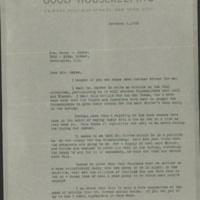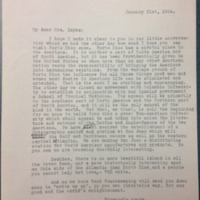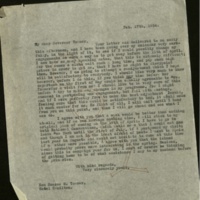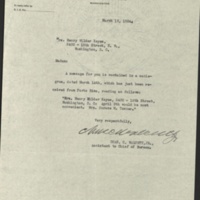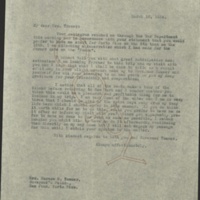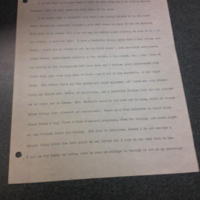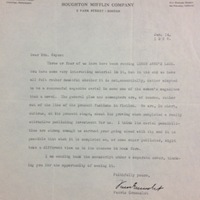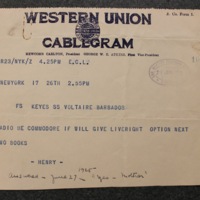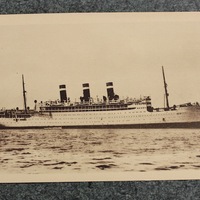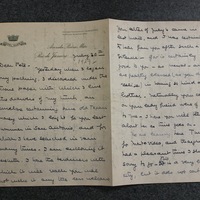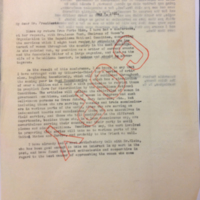Capitol Kaleidoscope : Travels
During congressional terms, Keyes was in Washington and in the summers she went to the family farm in New Hampshire. Harry’s mother had died in 1917 and his sister Belle died in 1920. The boys were often at camp and the farm was a place where she could write without disturbances. In addition to writing, Keyes began giving speeches to make more money for the family. This source of income continued for decades but Keyes recognized early on that making speeches, which also required attending the social events that surrounded them, often involved more “physical and mental strain” than writing books. And books, and articles, always reached a wider audience. [1]
As an associate editor and regular columnist at Good Housekeeping, Keyes had plenty of opportunities to reach a wide audience. But writing about Washington, no matter how vibrant its political culture, was not enough for her. Bigelow would sometime preface his demands for articles on specific subjects by asking Keyes to “chase down another writer for me.” In one instance, in 1923, it was a request that Keyes use her political contacts to secure an interview with Herbert Hoover to ask him to write an article for the magazine about the coal situation. The same year, Keyes was contacting another Hoover, the Chief Usher at the White House, to ask for help on another article.
Articles like these took Keyes deep into the politics of Washington and the nation but she wanted to expand her horizons and so in early 1925 she began discussing with Bigelow the possibility of making a round the world trip and reporting on her experiences in her monthly column. Her desire to travel was not just wanderlust. It stemmed from her experiences covering the 1921 Washington Arms Conference and 1922 Disarmament Conference, the 1922 Pan-American Conference of Women and the 1923 International Woman Suffrage Alliance Congress, and her experiences interviewing Mussolini, listening to the debates about the World Court and world peace, and her trips abroad, including to Puerto Rico, where she visited with its new Governor Horace Towner and her good friend Elizabeth Towner.
In May 1925, newspaper reports announced that Frances Parkinson Keyes was about to take a year-and-a-half “Round-the-World Swing.” [2] Her son Henry joined her for much of the trip, in part to placate Harry’s opposition to her travels. The State Department provided letters of introduction and helped arrange many of Keyes’s visits with high-ranking officials in different countries. Official luncheons were arranged and free transportation was sometimes secured. Bigelow also helped with the arrangements by using his own contacts. For example, Bigelow suggested that Keyes meet with Mrs. Horace E. Coleman, who was visiting Washington from Tokyo. Keyes invited Coleman to the regular luncheon of the “Ladies of the Senate,” where Coleman was introduced to First Lady Grace Coolidge. When she arrived in Tokyo, Coleman reciprocated by hosting a tea so Keyes could meet members of the Young Women’s Christian Association. Coleman also accompanied Keyes on her first visit to a Japanese home where she met Marchioness Nabeshina, the mother of Madame Matsudaira, who was the wife of the former Japanese Ambassador to the United States and Great Britain.
Creating the itinerary, making arrangements for the trip, and setting up connections with people to visit abroad took months of work. It was also an expensive undertaking and even though Good Housekeeping would be paying her expenses and providing her with remuneration for her articles, Keyes still had to make an initial financial investment in the trip. In April, Keyes told Bigelow that she had run out of funds to pay for what was needed in preparation for the trip and had to ask him to assist her in buying a new watch and trunk.
The business correspondence between Keyes and Bigelow provide a behind-the-scenes picture of her travels, which began in Cuba, continued through the Canal Zone, and took her west to Hawaii, Japan, China, Korea, the Philippines, Singapore, and Java. Then it was Egypt, Jerusalem, Turkey, Greece, Italy, and other countries in Europe. In September 1927 she left Marseilles for New York City.
Every month except during the summer of 1927, Keyes published an article in Good Housekeeping about her travels. These articles provided readers with an introduction to a world that many had not heard about, or had very little knowledge about, despite the international conferences already held and unfolding events such as volatile situation in China in 1925. [The articles are available to read in full Cornell University’s website, “The Home Economics Archive: Research, Tradition, History,” at http://hearth.library.cornell.edu/h/hearth/index.html.]
Keyes was given the grand tour whenever she arrived in a new destination but she took it upon herself to, whenever possible, visit villages and talk with people of all walks of life. In her June 1926 column, she made note of the resentments of the Chinese against European violations of their nation’s sovereignty. The next month she discussed the desire of Filipinos to see the end of U.S. colonial rule. During her Italy visit, she again interviewed Mussolini and again showed her admiration for him. In March 1927, however, she retracted her previous positive comments.
In the second half of 1929 and first half of 1930 Keyes was on the seas and road again, this time to Spain, Portugal, and South America. Her son John accompanied her and his photographs accompanied her essays in her first book of travel sketches, Silver Seas and Golden Cities: A Joyous Journey through Latin Lands. More travels and more travel articles were still to come. Again, she funded her trip by writing letters for Good Housekeeping. She also found other outlets for her writings, something she was had increasingly been doing for the last few years.
She continued to publish in the Delineator and Granite Monthly and added to these titles articles in McClures, Pictorial Review, and The Nation. In August 1927, she began publishing a regular column in Better Homes and Gardens, “Homes of Outstanding American Women.” She featured Assistant Attorney General Mabel Walker Willebrandt, politician Ruth Hanna McCormick, writer Dorothy Canfield Fisher, and other notable women in the column.
She continued writing her novels. When she finished Queen Anne’s Lace, she sent it to Houghton Mifflin; they rejected it and it was released by her new publisher, Liveright, in 1930. Lady Blanche Farm, from the same publisher, followed a year later, eleven years after it had been rejected by Houghton Mifflin. The novel was also a six-part serialization in the Canadian Home Journal.
Notes:
1) All Flags Flying, 205-206.↵
2) Boston Daily Globe, May 17, 1925. ↵
Related Documents

